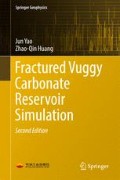Abstract
This chapter introduces the numerical simulation of mixed models for fractured medium. It starts with presenting the rules for dealing with the fractures during the modeling process. It then introduces the concept models that are usually used to describe the flowing characteristic of the fluids in fractured medium. However, the fractured medium is too complicated, so several kinds of mixed models, like coupled model and combined model, are introduced to realize better modeling. Then the categories, characteristics, and realization process of the coupled model are introduced. Also, the categories and realization process of combined model are introduced briefly.
Access this chapter
Tax calculation will be finalised at checkout
Purchases are for personal use only
References
Barenblatt GI, Zheltov IP, Kochina IN (1960) Basic concepts in the theory of seepage of homogeneous liquids in fissured rocks [strata]. J Appl Math Mech 24:1286–1303
Bour O, Davy P (1997) Connectivity of random fault networks following a power law fault length distribution. Water Resour Res 33:1567–1583
Bour O, Davy P (1998) On the connectivity of three-dimensional fault networks. Water Resour Res 34:2611–2622
Dreuzy J, Davy P, Bour O (2001) Hydraulic properties of two-dimensional random fracture networks following a power law length distribution: 1. Effective connectivity. Water Resour Res 37:2065–2078
Gong B, Karimi-Fard M, Durlofsky L, Gong B, Karimi-Fard M, Durlofsky L (2006) An upscaling procedure for constructing generalized dual-porosity/dual-permeability models from discrete fracture characterizations. Spe Annu Tech Conf, Exhib
Karimi-Fard M, Gong B, Durlofsky LJ (2006) Generation of coarse-scale continuum flow models from detailed fracture characterizations. Water Resour Res 42:382–385
Kazemi H, Merrill LS Jr, Porterfield KL, Zeman PR (1976) Numerical simulation of water-oil flow in naturally fractured reservoirs. Soc Pet Eng J 16:317–326
Lee SH, Lough MF, Jensen CL (2001) Hierarchical modeling of flow in naturally fractured formations with multiple length scales. Water Resour Res 37:443–455
Pruess K (2013) A practical method for modeling fluid and heat flow in fractured porous media. Soc Pet Eng J. 25:14–26
Sarda S, Jeannin L, Bourbiaux B (2002) Hydraulic characterization of fractured reservoirs: simulation on discrete fracture models. Spe Reserv Eval Eng 5:154–162
Wang Y, Yao J, Huang Z (2011) Review on fluid flow models through fractured rock. J Daqing Pet Inst 35:42–48
Warren JE, Root PJ (1963) The behavior of naturally fractured reservoirs. Soc Pet Eng J 3:245–255
Wu Y-S, Pruess K (1988) A multiple-porosity method for simulation of naturally fractured petroleum reservoirs. SPE Reserv Eng 3:327–336
Author information
Authors and Affiliations
Corresponding author
Rights and permissions
Copyright information
© 2017 Petroleum Industry Press and Springer-Verlag Berlin Heidelberg
About this chapter
Cite this chapter
Yao, J., Huang, ZQ. (2017). Hybrid Fracture Model. In: Fractured Vuggy Carbonate Reservoir Simulation. Springer Geophysics. Springer, Berlin, Heidelberg. https://doi.org/10.1007/978-3-662-55032-8_5
Download citation
DOI: https://doi.org/10.1007/978-3-662-55032-8_5
Published:
Publisher Name: Springer, Berlin, Heidelberg
Print ISBN: 978-3-662-55031-1
Online ISBN: 978-3-662-55032-8
eBook Packages: Earth and Environmental ScienceEarth and Environmental Science (R0)

